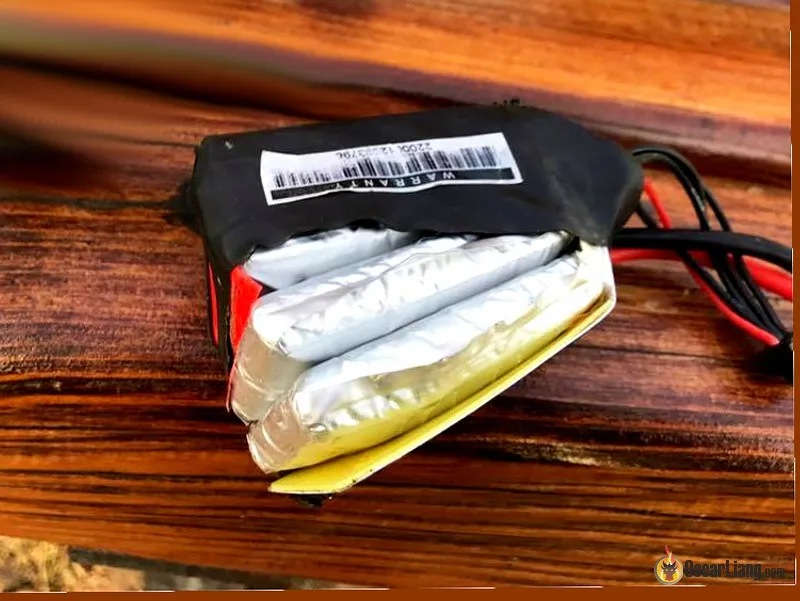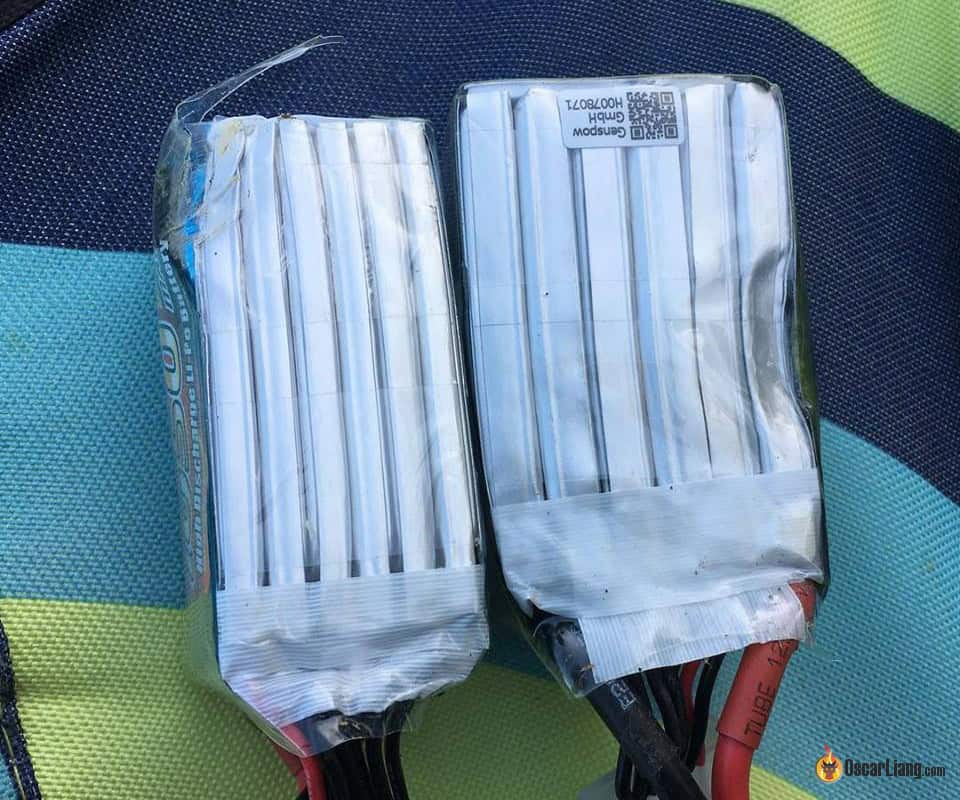Lithium Polymer (LiPo) batteries are commonly used in drones, but they can become hazardous if not handled properly. The inevitable question for RC hobbyists is how to get rid of old and damaged LiPo safely. Disposing of LiPo batteries is a delicate process that requires caution to prevent fires or explosions. Here’s what you need to know to safely dispose of LiPo batteries.
New to FPV? You can learn all the basics about LiPo batteries for FPV drone in this beginner’s tutorial.
Table of Contents
When To Dispose LiPo Batteries?
Lipo batteries used in FPV drones should be disposed of when they start to show signs of damage or wear and tear, or if they are no longer holding charge.
It’s important to dispose of them safely and responsibly to prevent any potential safety hazards or environmental harm. It’s also recommended to regularly inspect and monitor your lipo batteries for any signs of swelling, punctures, or leaks, and to store them properly when not in use.
This article explains how to determine whether a LiPo battery is old enough to retire.
Methods of LiPo Disposal
To summarize, when disposing of LiPo batteries, it’s important to discharge them completely to reduce the risk of fire. This means bringing the voltage down to 0 volt. Once discharged, take the battery to a local recycling facility for proper disposal.
Here are several ways you can discharge the battery.
Discharging with LiPo Charger
Most smart LiPo chargers are capable of discharging batteries. However, they are not designed for discharging LiPo completely for disposal, and usually have a cut-off voltage for safety (around 3.0V per cell). One example is the SkyRC BD350.
If this is the case, you might want to use other methods outlined below in order to discharge your battery completely.
Light Bulb Discharger
Discharging LiPo batteries with a light bulb is an affordable and speedy option.
In this tutorial I will show you how to built a halogen bulb LiPo discharger.
Avoid LED bulbs due to their forward voltage, which means they would stop discharging below certain level and there will be a small amount of charge left in the battery. LED are also more energy efficient which is not a desirable quality as a discharger. Halogen bulbs are a great choice.
LiPo Dischargers Using Power Resistor
Resistive loads, like radial ceramic resistors, are great options too. If you are building your own, consider using 150ohm 2W resistors for 2S/3S, and 5W 47ohm ones for 4S/6S. See this tutorial on how to build a resistor LiPo discharger.
Alternatively you can buy LiPo discharger here:
- AliExpress: https://s.click.aliexpress.com/e/_DlVXWsh
- Amazon: https://amzn.to/3UgNmPs
- GetFPV: https://oscarliang.com/product-wzeh
Other Methods
I covered many good ways to discharge your batteries ready for disposal in this article, including dedicated battery discharger, and high power resistors.
Salt Water (Avoid)
Discharging LiPo batteries using salty water is not the most recommended method as it is slow and ineffective. Salt water discharges the battery slowly over time, but it might not completely discharge the battery. Corrosion can also take place, where the exposed metal of the connectors/wires will have a layer of insulator building up in salt water. This might eventually stop the discharging entirely. However, many people still favour using salt water over other methods because it’s relatively safer as the battery is entirely immersed in water.
To discharge LiPo batteries with salty water:
- Get a plastic container and fill it with cold water
- mix it with salt until it dissolves completely. Use about 30g of salt per litre of water.
- Put the battery in the salty water, and leave it somewhere fireproof for two weeks or longer, depending on the original charge.
- Finally, wrap the battery with paper, and dispose of it at an authorized battery disposal facility.
Physically Destroying Battery (Just Don’t)
I’ve seen people do this on Youtube, the physically destroying method is not recommended and considered the most dangerous. We strongly advise against using a gun, a nail, a hammer, or a brick to puncture, shoot, or break the battery. Not only is this method fire hazardous, but the resulting smoke is harmful to inhale. It is better to use one of the other methods described in this guide to safely dispose of your LiPo batteries.
My Way
I normally use a halogen light bulb to completely discharge the battery first.
Check the voltage to make sure there’s is indeed no charge left – voltage should be close to 0V. Note that most battery checkers don’t work well when voltage drops below 3V per cell, and might report “no cell present”. Therefore it’s best to use a multimeter in this case, buy one here if you don’t have one already.
Then cut the connectors off, strip the wires and twist the discharge leads together to ensure there is no charge left in the pack (+ and -). You might get a spark when the wires first touch, the pack might even get warm, but it shouldn’t be an issue if the battery is empty. If you didn’t discharge it completely first as I mentioned, then you could get an overheat battery or even a fire if you short the positive and negative wires.
It only takes under 30 mins to dispose a LiPo which is far quicker than dipping the battery in salt water for weeks.

Don’t forget to save the XT60 and balance connectors for future use! If you have damages on a good pack you can use them for replacement.
Edit History
- Oct 2014 – Article created
- Jul 2016 – Updated
- Jul 2018 – Updated “Other discharging methods”
- Feb 2023 – Article revised




18 comments
you can also just leave it attached to a lost drone in a cornfield for 3 days. I did finally find it (that farmer mustve been using miracle grow by the ton) but the battery was completely discharged.
People should attach airtags to their drones so they don’t lose it
I just found a bunch of 6s lipo i accidentally left outside for years. Perfectly balanced still. So i discharged to 2.8v on lifepo4 setting then used nimh to get it down under a volt. Just unplug the balance lead so it doesnt know what youre up to
Been reading about this and it seems like the salt water method is outdated and potentially even dangerous. I think the light bulb method is decent. Best bet- it’s expensive but the isdt k4 charger actually has a “destroy” function which discharges the pack to 0.0V! Super cool. I can’t wait to get one. I have a cheaper but still decent charger now and once I’ve saved up imma get a isdt fo sho :)) cheers
It should be more clearly pointed out that, whilst less convenient, a low discharge current is always preferable to ensure maximum safety. The higher the discharge current the greater the convenience but the greater the need for monitoring of the discharge and the battery condition.
Also, it is not practically possible to have a simple single discharge device to suit a wide variation of pack cell counts and capacities for a given discharge rate (e.g. 0.1C) and discharge time (e.g. 10-12 hours).
2S 600mah @ 0.1C discharge current would require a resistor/load of value 123 ohms/0.4 watts.
3S 2000mah @ 0.1C discharge current would require a resistor/load of value 55.5 ohms/2.22 watts.
4S 5000 mah @ 0.1C discharge current would require a resistor/load of value 29.6 ohms/7.4 watts.
On balance, my preference would be a slow discharge (0.1C or less) in a bucket of sand placed in a suitably safe location! Why rush?
I use 3 cell packs that are “low” for my motor starters (large packs) and electrical drills (small packs that fit in battery case, ex 1300mah w/access to leads). Also in portable compressors w large packs.
This video will teach you everything you need to know: youtube.com/watch?v=49maaWRQOog
Fun video lol :D
Point to add, if you agree, then short the main wires after fully discharging so that no charge can build up again.
Emh… I think I did mention that. But thank you anyway for emphasizing that :)
Electrolysis of salt water produces chlorine gas. It is a very deadly gas.
You can hand them in at the used battery collection point at the hardware store, but in reality a full depleted LiPo battery contains only lithium salt(s), cobalt/manganese/graphite, water and plastics, neither of which are considered toxic chemicals and can be handled by the normal waste processing plants.
A light bulb is a resistive load and a motor is an inductive load
From the perspective of draining a battery, the battery doesn’t particularly care whether the load is resistive or inductive, so long as the current draw isn’t so high that it goes into thermal runaway.
There are many good other uses for old Lipo batteries , such as running all sorts of appliances esp if they are still holding correct volts but not giving good amps, i do music and use them for my effects boards and led light circuits, use for handsets & goggles, maybe good for pedal bike lights, head torches etc, if anyone is doing FPV racing n making their own hoops n markers , why not light them up for night time fun using EL wire ( ebay.co.uk/itm/271866563089?_trksid=p2060353.m1438.l2649&var=570702685340&ssPageName=STRK%3AMEBIDX%3AIT ) and old lipo batteries to power them up :)
Any shop that sells batteries should recycle the batteries they sell, so for lipos….that’s everywhere, just take them to a shop and ask them to get rid. do it before we (if) brexit.
I check the LiPo for dead cells first. If cell 1 or cell 4 are dead I remove the faulty cell and then have a test 3S for
flight tests.
salt water corrodes and eats away at the tabs that connect the wire to the cell, so when you measure voltage from the connector you get a 0 Volt reading because its now an open circuit. the cell still has energy in it.